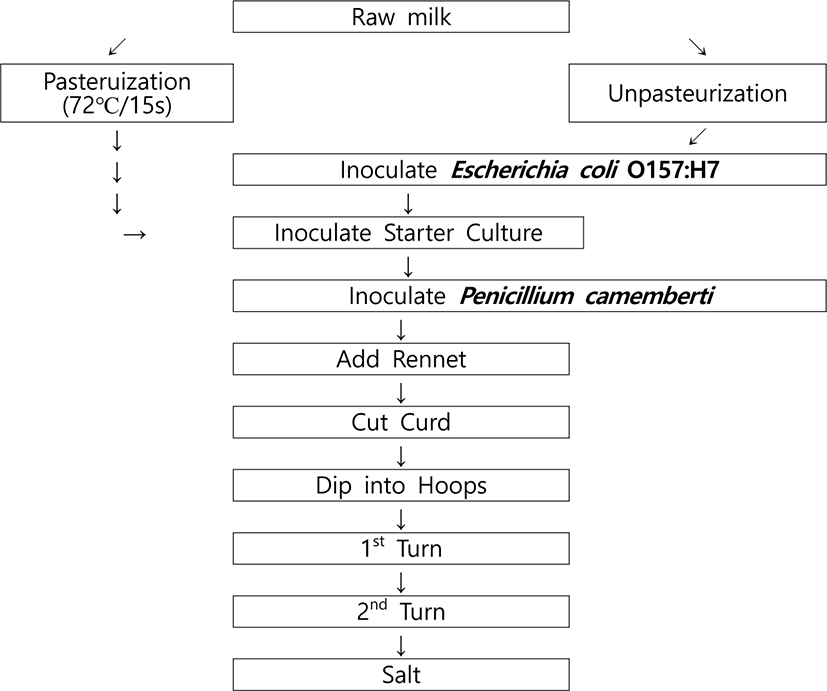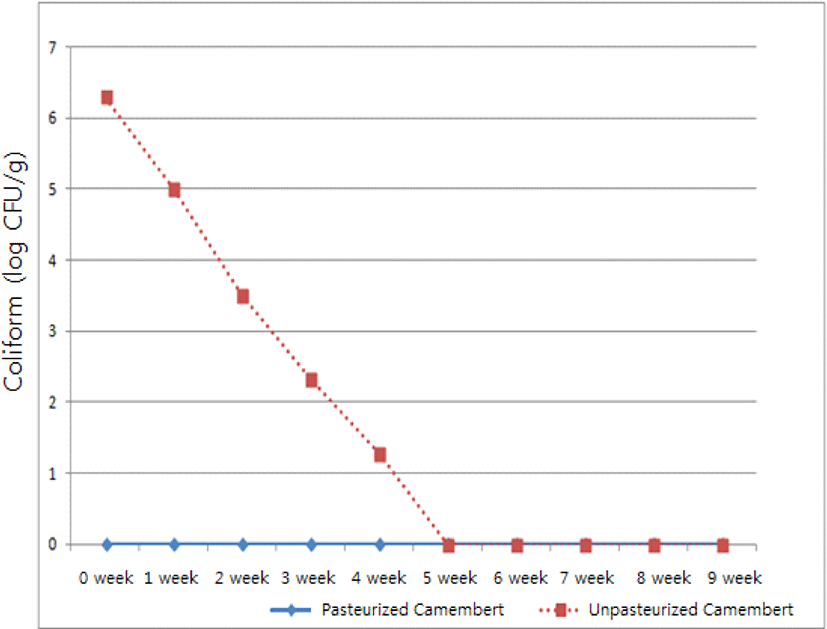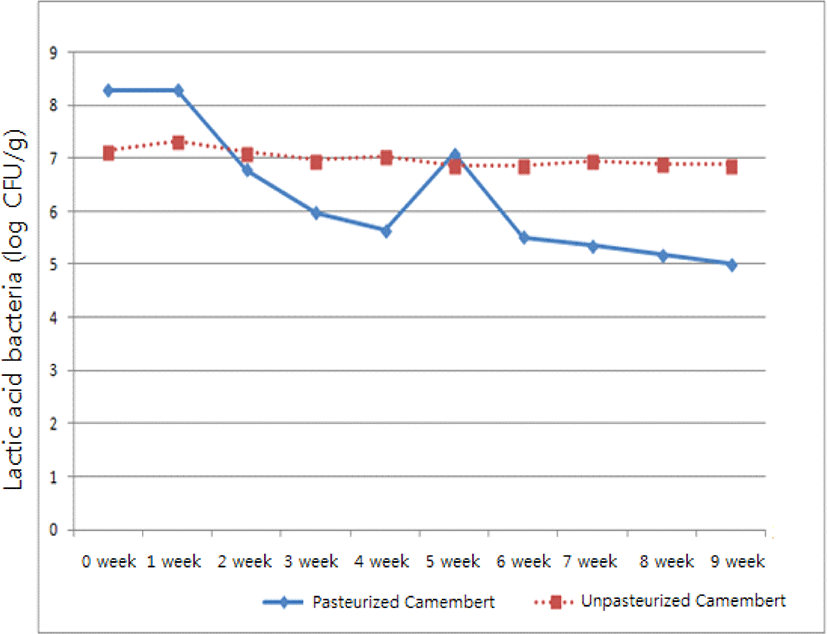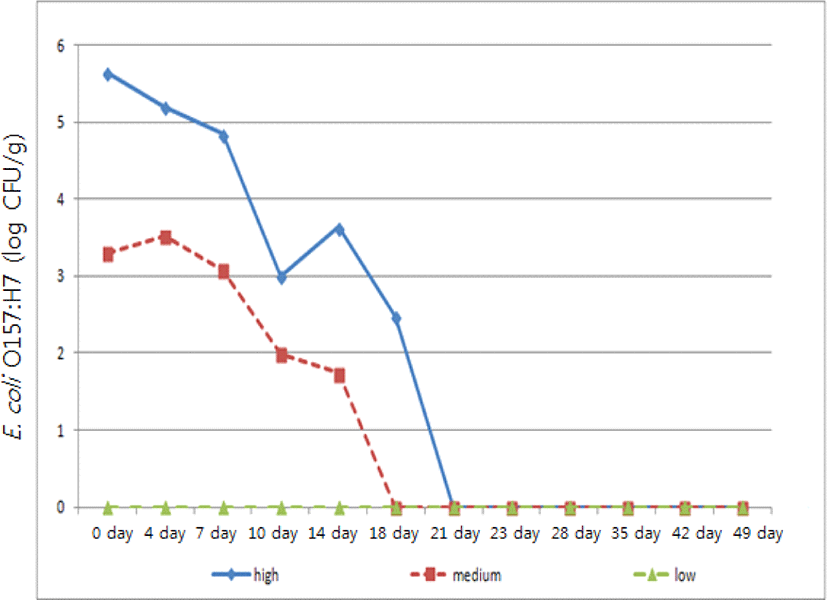Introduction
As a characteristic of bacteria, enterovirulent Escherichia coli in general causes acute gastroenteritis in humans [1-3]. One of the pathogenic E. coli is called enterohemorrhagic E. coli, of which E. coli O157:H7 is the most famous [2,4]. E. coli O157:H7 is also commonly referred to as ‘O-157’ for short because of its long name [1-4]. In addition, to explain the meaning of enterohemorrhagic E. coli in detail, entero is translated as ‘intestine’, hemorrhagic as ‘bleeding’, and E. coli as ‘Escherichia coli ‘, resulting in ‘Escherichia coli ‘ that causes bleeding in the intestine’ [4,5]. In other words, enterohemorrhagic E. coli is E. coli that causes bleeding in the large intestine, and O-157 is one of the bacteria [4-6]. O-157 bacteria produce one or more potent toxins that severely damage the surface of the intestinal tract [6]. The toxin produced by O-157, called verotoxin or shiga-like toxin, is the same as or closely related to the toxin produced by Shigella dysenteriae [7,8]. As an acute disease, E. coli O157:H7 causes an acute disease called ‘hemorrhagic enteritis’ [1-8]. The disease is characterized by severe cramping abdominal pain and diarrhea [1-8]. Diarrhea is initially watery, but changes to bloody stools [1-8]. It is sometimes accompanied by vomiting [1-8]. There may be no fever or a slight fever may occur [1-8]. The disease goes away on its own, but lasts for an average of 8 days [5-8]. Depending on the patient, only watery diarrhea may appear. Infective dose is known to be about 10 CFU like bacillary dysentery [9]. Related foods include alfalfa sprouts, unpasteurized fruit juice, dried salami, wild game meat, lettuce, cheese, etc. This food is known to cause O-157 food poisoning [10-12]. In a school in Canada, unpasteurized milk was the cause of a food poisoning accident [13].
Camembert is a small village located in Normandy in northern France [14,15]. Camembert, about 5 km from Vimoutiers, is a small rural village on a hill in Normandy with only about 200 residents running the village [14-16]. Camembert is a white mold cheese made by inoculation with Penicillium camemberti [17]. This is because the enzyme produced by the white mold breaks down the protein and the acidity becomes very low [17,18]. E. coli O157:H7 bacteria, which are acid-resistant pathogens, are a problem [13,14]. Because these bacteria are acid-resistant, they survive at the pH of the initial stage of cheese production and proliferate when the pH of cheese increases as the ripening progresses, causing food poisoning [19]. Camembert cheese made with unpasteurized raw milk requires special attention to hygiene and safety management compared to hard-ripened cheese [14-19]. In order to prevent the contamination of the Camembert cheese ripening room by residual pathogens, the maturation chamber must be cleaned and disinfected regularly.
In Korea, in the case of cheese manufactured using unpasteurized raw milk, the sale of aged cheese for 60 days is allowed in the manufacturing and processing standards of cheese of the revised Food Code, which is applied from January 1, 2018 [20].
However, milk as a complete food is a very useful food, but it is a food that is easily affected by the external environment due to the quality of milk [20]. For this reason, unpasteurized cheese manufactured without sterilization of raw milk must be supervised according to very strict standards so that Korean consumers can recognize the safety of unpasteurized raw milk cheese. Furthermore, it is believed that it will be able to revitalize the Korean cheese industry.
Furthermore, through free trade agreement (FTA) negotiations between Korea and the United States, Europe, Australia, and Chile, various foreign cheeses are currently being imported [20]. Among imported cheeses, countermeasures such as unpasteurized cheese are urgently required. In addition, it is necessary to prepare for this because the regulations on sterilization of raw milk used in cheese production and the ripening period for cheese made with non-sterilized whey milk differ from country to country.
Therefore, in this study, Camembert cheese made from unpasteurized raw milk was inoculated with E. coli O157:H7 strains at various concentrations to evaluate the safety of unpasteurized Camembert cheese during the ripening storage period of more than 60 days.
Materials and Methods
High-quality unpasteurized raw milk that passed various raw milk tests was purchased from Konkuk Milk and used in this study. Lactococcus lactis subsp. cremoris, Laccococcus lactis subsp. lactis, Lactococcus lasctis subsp. lactis biovar. diacetylactis, Streptococcus salivarius subsp. thermophilus, and Lactobacillus helveticus were purchased from SAMIK Dairy & Food. Each lactic acid bacteria was subcultured three times in 10% sterilized skim milk to improve vitality and then used at the time of inoculation. Standard plus 900 (Chr. Hansen, Denmark) was used as the clotting enzyme, rennet. And P. camemberti was purchased from SAMIK Dairy & Food and used in the manufacture of Camembert cheese.
E. coli O157:H7 was donated from the US FDA (5100 Paint Branch Parkway, USA). E. coli O157:H7 is a strain isolated from food. While stored at –70°C in the laboratory, the strain was thawed and used whenever necessary. The thawed strain was spread on Nutrient agar (Oxoid, UK) and incubated aerobically at 37°C for 24 hours. A single colony was selected from the cultured colonies and cultured in Tryptic Soy Broth (Oxoid) at 37°C for 24 hours, and the bacterial solution subcultured three or more times was diluted and used as an inoculum.
Camembert cheese was prepared according to the method of Ryser & Marth [21] (Fig. 1). In this study, Camembert cheese produced by pasteurized raw milk was used as the control group, and Camembert cheese was manufactured with unpasteurized raw milk as the treated group. Camembert cheese made from unpasteurized raw milk was inoculated with E. coli O157:H7, a pathogenic bacterium, at various concentrations, and changes during the storage period of more than 60 days were observed. After draining overnight at room temperature (about 23±2°C), Camembert cheese were dry-salted and then ripened 10 days at 15±1°C with 90±5% relative humidity so as to enable to desirable growth of P. camemberti. And after 10 days, Camembert cheese were wrapped in foil and ripened at 6°C.

The number of lactic acid bacteria was measured as follows. Add 225 mL of phosphate buffer diluent to 25 g of Camembert cheese sample. Homogenize for 1 minute using a stomacher blender, Bag mixer (Interscience, USA). After serially diluting 100 μL by 10-fold dilution unit, spread on MRS agar (Difco, USA) and incubate at 36°C for 48 hours. White coli colonies on MRS agar were counted as lactic acid bacteria.
The coliform count was measured as follows. Add 225 mL of phosphate buffer diluted solution to 25 g of camembert cheese sample and homogenize for 1 minute using a stomacher blender, Bag mixer (Interscience). Take 100 μL, dilute by 10-fold dilution unit, spread on coliform dry film (3M Petrifilm, USA) and incubate at 36°C for 24–48 hours. Among the red colonies on a dry film (3M Petrifilm), colonies forming air bubbles were counted as the number of coliforms.
E. coli O157:H7 measurement is as follows. Add 225 mL of phosphate buffer diluted solution to 25 g of camembert cheese sample and homogenize for 1 minute using a stomacher blender, Bag mixer (Interscience). Then, 100 uL was diluted in a 10-fold unit, spread on sorbitol MacConkey agar (SMAC; BD Difco, USA), and incubated at 37°C for 24 hours. Colonies formed on SMAC (BD Difco) were counted as E. coli O157:H7.
The pH measurement is as follows. For pH change, saline and Camembert cheese are added to a grinding tube in a ratio of 2:1 (saline:cheese=20 mL:10 g). And after homogenizing at 12,000 ×g for 2 minutes, it was measured with a pH meter (Istek Model 720p, Korea).
Water activity (aW) measurement is as follows. Water activity was measured three times using a Benchtop water activity meter (Aqualab, USA), and the average value was expressed as the water activity value of Camembert cheese.
Results and Discussion
The pH of Camembert cheese made from pasteurized raw milk changed from 4.86 at 0 week to 5.93 at 8 weeks (Table 1). The pH of Cheddar cheese made from unpasteurized raw milk ranged from 5.04 at 0 week to 5.47 at 8 weeks (Table 1). The pH of Camembert cheese prepared by inoculating unpasteurized raw milk with E. coli O157:H7 was varied. When the inoculation amount of E. coli O157:H7 was high, the pH was 5.10 at 0 week to 5.49 at 8 weeks (Table 1). When E. coli O157:H7 was inoculated with Medium, the pH was 4.93 at 0 week to 5.19 at 8 weeks (Table 1). And when the inoculation amount of E. coli O157:H7 was low, the pH was 5.06 0 week at to 5.33 at 8 weeks (Table 1). It was found that the pH value of Camembert cheese was generally inconsistent during the ripening storage period. This is thought to be because the surface of Camembert cheese is covered with white mold by white mold and the inside appears as a typical cheese.
The results of this study were similar to those of Ryser & Marth [21] and Meyrand et al. [22].
The aW (water activity) of Camembert cheese made from pasteurized raw milk changed from 0.9266 at 0 week to 0.8810 at 8 weeks (Table 2). The aW (water activity) of Camembert cheese made from unpasteurized raw milk ranged from 0.9225 at 0 week to 0.8976 at 8 weeks (Table 2). The aW of Camembert cheese prepared by inoculating unpasteurized raw milk with various concentrations of E. coli O157:H7 was varied. When the E. coli O157:H7 inoculum was high, aW was 0.9454 at 0 week and 0.9209 at 8 weeks (Table 2). When the E. coli O157:H7 inoculum was medium, aW was 0.9164 at 0 week and 0.9157 at 8 weeks (Table 2). And when the E. coli O157:H7 inoculum was low, aW was 0.9528 at 0 week and 0.9072 at 8 weeks (Table 2). In the case of Camembert cheese, the overall aW (water activity) decreases slightly as the aging period increases, which is thought to be due to the loss of moisture as Camembert cheese is not vacuum- packed [23].
Fig. 2 shows changes in coliform counts during ripening storage of Camembert cheese made from pasteurized and unpasteurized raw milk.

In the case of Camembert cheese made from unpasteurized raw milk, it was observed that the number of coliforms gradually decreased during the aging storage period, and from the 5th week, it was observed that the coliforms completely disappeared and were not detected. On the other hand, in the case of Camembert cheese made from pasteurized raw milk, no coliforms were detected from the beginning to the 8th week (Fig. 2).
Fig. 3 shows the changes in the number of lactic acid bacteria during the ripening storage period of Camembert cheese made from pasteurized and unpasteurized raw milk.

In the case of Camembert cheese made by pasteurized raw milk, it was observed that the number of lactic acid bacteria decreased during the aging period. However, in the case of Camembert cheese made from unpasteurized raw milk, the number of lactic acid bacteria remained constant during the maturation period without significant change (Fig. 3).
Qualitative tests for E. coli O157:H7 were simultaneously conducted in Camembert cheese made from unpasteurized raw milk, but all were negative during the aging period (Data not shown).
Table 3 and Fig. 4 show the changes in E. coli O157:H7 during the ripening period of Camembert cheese prepared after inoculating unpasteurized raw milk with the pathogenic bacteria E. coli O157:H7 at various concentrations.

A variety of Camembert cheeses were prepared by inoculating E. coli O157:H7 into unpasteurized raw milk. For High, 4.3×105 CFU/g of E. coli O157:H7 was inoculated, for Medium, 2.0×103 CFU/g of E. coli O157:H7 was inoculated, and for Low, <10 CFU/g of E. coli O157:H7 was inoculated, respectively (Table 3).
The results of E. coli O157:H7 quantitative detection are as follows. High with 4.3×105 CFU/g of E. coli O157:H7 inoculation amount showed 0 CFU/g at 5 weeks, Medium with 2.0×103 CFU/g of E. coli O157:H7 inoculation amount showed 0 CFU/g at 5 weeks, and Low with<10 CFU/g of E. coli O157:H7 inoculation amount showed 0 CFU/g at 5 weeks, respectively (Table 3).
The result of E. coli O157:H7 qualitative detection is as follows. In the case of E. coli O157:H7 inoculation amount High, (+) at 0 week was observed as (–) at 5 weeks. In the case of E. coli O157:H7 inoculation amount Medium, (+) at 0 week was observed as (–) at 5 weeks. And in the case of E. coli O157:H7 inoculation amount Low, (+) at 0 week was observed as (–) at 5 weeks (Table 3).
In the case of Camembert cheese, the number of E. coli O157:H7 tended to decrease rapidly. When the inoculation amount was High or Medium, the Camembert cheese was negative from the 5th week in the qualitative test, whereas in the Camembert cheese with the low inoculation amount, E. coli O157:H7 was not found in the qualitative test from the 4th week (Fig. 4).
According to a research report by Ramsaran et al. [24], Camembert cheese and Feat cheese were prepared after inoculating 104 CFU/mL of E. coli O157:H7 into pasteurized and unpasteurized raw milk respectively. After manufacturing, the survival of microorganisms was investigated after storage at 2°C for 65 and 75 days [24]. It was reported that E. coli O157:H7 was detected in both Camembert cheese and Feat cheese. Furthermore, E. coli O157:H7 was detected in the brine used for Feta cheese on 75 days [24].
In this study, in order to experimentally verify the safety of cheese aged for more than 60 days manufactured with unpasteurized raw milk, this study was conducted to compare and verify cheese made through aging as in Europe and cheese made with pasteurized raw milk. Camembert cheese, a soft cheese, was selected. As a result of this study on microbiological properties and safety, there was no significant difference in the number of lactic acid bacteria in cheese between unpasteurized raw milk-manufactured cheese and pasteurized milk-manufactured cheese. In addition, in the case of coliforms, a large number of 6 Log CFU or more was present in unpasteurized cheese, but all of them were removed after the 5th week, and it is considered that there is no big problem in terms of hygiene when ripening. Considering the infection amount of the pathogen, it is evaluated that it cannot necessarily be seen that food poisoning is caused below the infection amount. However, considering the risk of bacteria, it is absolutely necessary to control proliferation through proper storage and aging process after cheese production. However, since this study was conducted under specific conditions by manufacturing Camembert cheese with pathogens that are problematic in certain cheeses, then it seems that there is a need for a wide range of additional experiments applying various conditions, cheeses, and pathogens in the future.
In the 2000s, several studies were published that showed that aging of unpasteurized cheese for 60 days was not safe [25-27]. Also, in 2010, special attention should be paid to the fact that the issue of cheese safety is being reviewed at the US FDA level [28]. In other words, it is considered that additional scientific data should be observed and judged. Currently, in Korea, E. coli is a bacterium to which negative standards are applied, and it is an important food poisoning causative agent in cheese [20]. It is necessary to establish reasonable standards for cheese at the level of developed countries in preparation for FTA by conducting additional scientific risk assessment studies on the pasteurization equivalence of these bacteria. Internationally, many countries allow unpasteurized aged cheeses longer than 60 days. However, it is premised that items equivalent to pasteurization are strictly applied, such as storage temperature regulations, aging conditions subdivided for each cheese, and labeling regulations specifying that they are manufactured with unpasteurized milk. Therefore, it is expected that the cheese manufacturing process and ripening period can have the same effect as cheese using unpasteurized raw milk only when hygiene management guidelines such as HACCP are properly applied and thoroughly managed during the production process and ripening period. Therefore, research on this is also urgently required.






